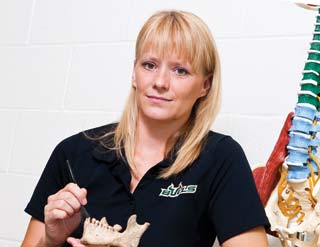Voices
Erin Kimmerle
| USF News

Photo by Aimee Blodgett | USF News
From the time she was 9, Erin Kimmerle knew she wanted to be a cultural anthropologist. But when she learned about the human rights work being done by renowned forensic anthropologist Clyde Snow during an undergraduate class, she shifted her focus to the field of forensic anthropology.
Forensic anthropology is the study of bones to help law enforcement agencies identify human remains and draw conclusions about the circumstances of death ranging from homicide and suicide to genocide and war crimes.
For Kimmerle, assistant professor in the Department of Anthropology, it has been the basis for a remarkable career. Kimmerle's work has taken her to some of the region's best known crime scenes and across the globe to investigate human rights violations in Nigeria, Kosovo, Bosnia-Herzegovina and Croatia. She was the chief forensic anthropologist for the United Nations, International Criminal Tribunal for the former Yugoslavia and also worked as an osteologist for the Smithsonian Institution's Museum of National History.
Today, in addition to her teaching and scholarship, which includes directing the Forensic Anthropology Laboratory at USF, Kimmerle is a member of the Florida Emergency Mortuary Operations Response System. She received her degrees in anthropology from the University of Tennessee (PhD), the University of Nebraska (M.A.) and Hamline University (B.A.).
USF: How does a forensic anthropologist contribute to an active crime scene investigation?
In a couple of ways. Police may call and ask for assistance in searching for a clandestine grave. Or, they may call for help with identification once they've found a body, skeletized remains or a burial.
USF: What about a cold case?
Forensic anthropologists create facial reconstructions and biological profiles to help with human identification and trauma analysis.
USF: What is the most important thing you look for at a crime scene?
Bones. I'm focused on finding all the bones.
USF: What are some of the methods and tools you use to solve a case?
Digitizing and measuring skills for metric analysis as well as samples of bones and teeth for chemical isotope analysis to determine where people come from.
USF: What has been the greatest advance in forensic anthropology?
Three-dimensional morphometric tools that allow us to estimate ancestry.
USF: You've said forensic anthropology is a foundation for human rights. How so?
Nigeria (the Asaba massacre) is a good example. Forensic anthropology is about access to justice. In so many places there has not been any type of accountability — gross human rights violations occur and go unnoticed. By having a forensic anthropologist in a working judicial system, you are providing access for people to justice and accountability.
USF: What are some of the challenges you face in other countries?
Security, infrastructure, power, Internet access and lack of basic equipment. We tend to work in really remote parts of countries post-conflict, and there are always multiple perspectives — one person's war criminal is another person's hero.
USF: What is the focus of your research?
How populations vary in terms of aging and how we can best determine age based on skeletal remains.
USF: What is the most important thing you teach your students?
Teamwork. Everything in forensics, forensic anthropology and life is about teamwork.
Quick Takes
Best TV crime show: Law & Order
Past or present: Present
Hot case or cold: Cold
Your hero: Clyde Snow
Class work or fieldwork: Fieldwork